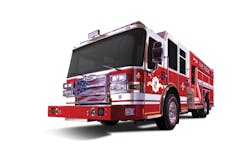The November installment of The Apparatus Architect reviewed some history regarding fire apparatus cab design and the impact of staffing on seating positions and arrangements. Over the years, with the advent of four-door-cab apparatus, more seating and equipment storage options have been developed by manufacturers to address the needs of the fire and emergency services. At a national level, studies are being conducted to validate criteria that were developed years ago regarding the anatomical characteristics of fire and emergency personnel. The results of this analysis will have a profound impact on future apparatus designs for seating positions, stepping surfaces, handrails and many other areas.
Today, many departments are operating with four to six personnel under the best of conditions. With this in mind, manufacturers are looking at ways to maximize the available space inside cabs for personnel, radios and computer equipment, protective gear and other tools and equipment. Each of these areas must be carefully considered by a department to ensure it is meeting the objectives of the apparatus. Honest answers to the four questions first raised in Part 52 of The Apparatus Architect provide a solid basis for the design of your new unit:
- How many personnel normally will be assigned or will ride on this unit?
- What map books, computer and resource materials must be readily available for the officer?
- Where will protective gear be stored during non-emergency responses?
- What tools and equipment will be mounted and secured in the cab or an adjacent area?
One of the constant fire service complaints about current production cabs is the lack of room for the driver and officer’s seat positions. With the changes in engine emissions technology and electronics, today’s diesel engines need more room for cooling and exhaust systems, leaving little room for other critical chassis components. As most custom fire chassis incorporated tilt-cab/engine-forward designs until recently, there was little that could be accomplished to improve the cramped working areas for the driver and officer.
Earlier in 2011, Pierce Manufacturing introduced the Dash CF cab and chassis to address many space, visibility, safety and maintenance issues by relocating the engine back toward the rear in between the crew seats and into the frame rails. This new cab design allows the driver and officer’s seat locations to be moved inward, improving the amount of leg, elbow and shoulder room. The Dash CF is 96 inches wide with an interior width of 92 inches, wall to wall.
When entering the cab, you notice that the first step into the cab is much lower to the ground, making egress much easier and comfortable. The two front steps are 18½ inches from the ground with the height of the step to the cab floor being 16½ inches. Inside the driver’s door on the A-post is long handrail that assists with entry into this area. The crew cab steps are only slightly higher and provide a non-slip surface.
With the increased use of electronics, dashboard gauges and controls are sometimes scattered in different locations across the width of the cab. In addition, with radio and computer laptop mounting, the line of sight for the driver is limited when looking through the windshield over to the officer’s side of the cab. Some departments have installed bumper guide posts and windshield-mounted down-view mirrors to let the driver see the right-hand corner of the apparatus at the front bumper. The Pierce engineering team was able to lower the windshield some 10 inches, providing almost unlimited vision for the driver when seated and belted, with no portion of the dashboard blocking the line of sight.
Safety measures sometimes come in small areas, such as location of dashboard instruments, emergency warning light controls, hazard indicators and other components. The Dash CF enjoys a logical arrangement of controls for the driver, particularly the position of the accelerator and brake pedals, which have been problematic in some apparatus designs in the past. The floor area between the driver and officer’s seats is open across the full width of the cab with the forward portion of the engine cover providing a logical mounting location for map books and other resource materials.
With the engine located in the rear of the cab, two seats are provided on each side, one forward and one rear facing, each equipped to hold self-contained breathing apparatus (SCBA). The engine box area measures 39 inches wide by 83 inches long and sits 23 inches above the level of the floor. The top, flat surface is a natural area to mount equipment such as handlights, portable radios and irons. With a ceiling height of 61 inches in the front of the cab and 70 inches in the crew area, there is adequate room for personnel to safely egress these areas.
There are more than several schools of thought regarding the amount of equipment storage that should be permitted inside of the cab. For those few departments that feel they need more than six seating positions, the available space remaining inside the crew area is very limited and by the time you mount a hand light and portable radio for each member there is no open area left for hand tools and equipment. This is where department standard operating guidelines (SOGs) and training come into play. Depending on your staffing and response patterns, each seat on the apparatus should have a riding assignment to detail the specific job functions that each firefighter is responsible for, including tools and equipment that each should carry and be responsible for at the scene of the incident.
The Pierce Dash CF provides more than sufficient room inside the cab to carry those essential pieces of equipment that a battle-ready firefighter would need immediately on exiting the cab. Safety is a mindset that all fire departments should strive to instill with their personnel when operating on apparatus and at the scene of any incident. The engineers at Pierce have a done a creditable job to assess many of the current problems with cab design and safety in addition to bringing about a reality check with respect to the size and overall length of a practical piece of fire apparatus.
With the cost of new apparatus, down time and maintenance costs becoming more of an issue, particularly where departments do not have their own shops or repair facilities, several maintenance-friendly features have been incorporated into the Dash CF. These include a drop-down panel on the officer’s side of the cab that permits access to electrical components, battery charges and windshield wiper motors. Fluid checks and fills for the engine and transmission are through a hinged access door at the left-side crew cab door with chassis filters all at one location outside of the frame rails. The chassis batteries are protected inside of the frame with ready access to the alternator and air cleaner.
With the number of innovations on the Pierce Dash CF chassis, there will be some skeptics who are critical of the concepts and designs put forth with this unit. Many times we have heard the term to describe the fire service as “200 years of tradition unimpeded by progress.” Since the first steamer was introduced back in 1854, the fire service with few exceptions has been slow to universally accept new technology in many areas. Consider that while metal, hydraulically raised aerial ladders were developed in 1935, many departments continued to prefer wooden, spring-raised aerial ladders, which were built by several manufacturers until 1955.
For many years, the cab-forward design was the predominant product available to the fire service. Departments across the United States used this type of custom cab to provide seating for four personnel and any additional members had to ride on the back step or were exposed in the jump seat area. Safety concerns, together with demographic changes in the inner cities, created a new era of cab designs to provide enclosed seating areas for all personnel. These changes, together with market-driven innovations such as the Pierce Dash CF, should provide a number of positive choices for fire departments to consider when specifying new apparatus for their fleets.
Future articles will look at recent success stories on how departments integrated safety and operational enhancements into new engine apparatus. Who says history does not repeat itself?
TOM SHAND, a Firehouse® contributing editor, is a 36-year veteran of the fire service and works with Michael Wilbur at Emergency Vehicle Response, consulting on a variety of fire apparatus and fire department master-planning issues. MICHAEL WILBUR, a Firehouse® contributing editor, is a lieutenant in the New York City Fire Department, assigned to Ladder Company 27 in the Bronx, and has served on the FDNY Apparatus Purchasing Committee. He consults on a variety of apparatus-related issues around the country. For further information, access his website at www.emergencyvehicleresponse.com.







